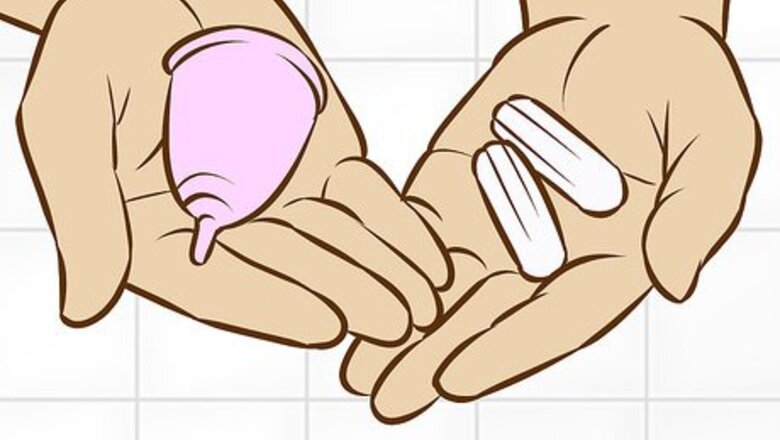
views
Understanding Tampons and Your Body
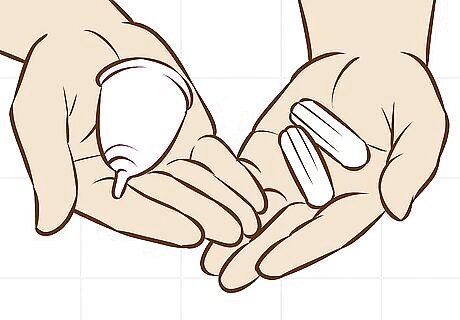
Learn about tampons and alternatives. You don’t have to use a tampon while on your period. In fact, many people prefer to use pads or menstrual cups. Tampons provide more freedom in motion and are sometimes better when playing sports, especially those involving water. However, tampons can require some effort with handling or insertion. Sanitary pads are worn within your underwear and catch the blood flow. They come in a variety of sizes from slim liners, designed for short term use, to overnight styles. Many women find pads to be bulky and cumbersome; however, they are easy to use and a safe option if you are concerned about forgetting to switch out tampons regularly. A menstrual cup is a flexible, small rubber cup that fits inside your vaginal canal. You insert it by hand and it then collects the blood. You have to remove it at intervals in order to rinse out the collected blood before repeating the process. People who are worried about a tampon's materials may be more comfortable with this option. However, you do have to learn how to properly remove and insert the cup.

Get to know the parts of a tampon. After you open the plastic package of the tampon, you will see the tampon itself and the attached string. The applicator is the harder plastic cover that includes a barrel covering the absorbent interior, a grip area for your fingers to hold onto, and a plunger to help push the tampon inside of you. Go ahead and turn a tampon over in your hand and take a close look. If you are worried about the string for removal, go ahead and give it a tug or two. You will see that it is very snug and not likely to break off. If it makes you more comfortable, you can plan on testing the string of each tampon before using it. Also, get into the habit of taking a good look at the outside packaging. Never use a tampon that comes from a ripped or torn package.

Select a light-flow, slim tampon with a built-in applicator. There are a whole bunch of different brands to choose from, and you can do online research to find one that will work for you. If you're using a tampon for the first time, it might be easier to start with a slimmer product. You can also buy a mixed box with larger tampons intended for heavier flow days as well. Only use these after you’re comfortable with the entire process. You can also buy just tampons without the applicators. These will require that you use your finger to insert the tampon. The applicator included style tampons are generally the best ones to use at first as they are easier to handle.
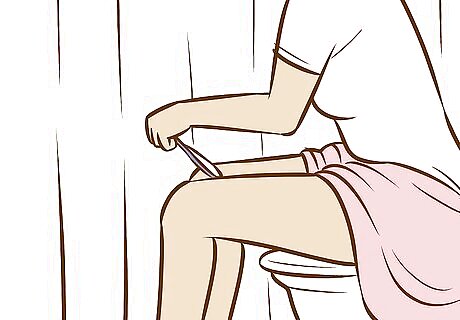
Learn more about your body and reproductive system. Go to a private place, such as the bathroom, sit on the toilet and use a hand mirror to examine your vulva, also known as your outside genitalia. Don’t be afraid; you really can’t hurt yourself. You will notice that your vaginal opening is the middle area and a smaller hole, your urethra (for urination) is in the area as well, but is smaller. You will insert the tampon within your vaginal opening. Getting to know your body will make you feel more confident about using a tampon properly. Make sure to always wash your hands before and after touching your vagina. This will ensure that you do not pass germs along. It may appear as if your vaginal opening is not large enough to accommodate a tampon, but this is generally not the case. With a bit of lubrication, often period blood, this opening will stretch wide enough. If you do a bit of research online regarding female anatomy, you will see that it is also not possible to lose your virginity by using a tampon. It is unlikely that a tampon will tear your hymen (the tissue that covers your vaginal opening deep in the interior). And, the loss of virginity requires sexual intercourse. Additionally, virginity is a social construct, so there's no need to worry about it if you don't want to.
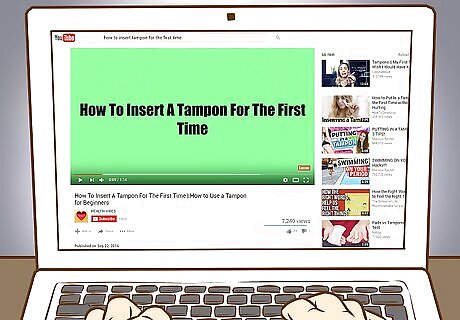
Look at online diagrams or videos showing tampon insertion. There are many reputable websites, including The Period Blog, which provide step-by-step images showing how to insert and remove a tampon. Some sites will even let you ask a question in the comments area, to be later answered by the moderator. It is also a good idea to read the instruction sheet that came with your package of tampons. This sheet often shows a usage diagram, as well and lists safety information as well. Studying your anatomy and usage charts will also show you that your vagina is essentially a canal with the cervix as its end point. This means that it is not possible to permanently “lose” a tampon within you. This is a myth.

Ask a relative or friend for advice. If you have an older friend who has started their period and is familiar with using tampons, you might talk with your friend about how to use them. They can provide you with some tips or suggestions. Your mom or another relative might also be helpful. Just make sure that whoever you talk to will keep questions and concerns private. For example, you might say, "I'm about to try using a tampon for the first time. Do you have a particular brand that you'd suggest I buy?" Or, "Do you have anything that you suggest I should do to make the first time easier?"

Talk with your doctor or the school nurse. Ask your parents to make an appointment for you to meet with your pediatrician or general doctor. Or, if you trust them, go to the school nurse and ask to have a private conversation with them. Explain your situation and ask any questions that you have. You might say, "I'm thinking about starting to use tampons. What are some of the possible risks? What are the benefits of tampons versus pads?" This is a good time to consider whether you trust and are comfortable talking with your main doctor. If not, you may want to talk to your parents about switching to another one.
Creating a Positive Experience

Find a place where you won’t be interrupted. When you are ready to try out a tampon, make sure that you go to a place where no one will bother you. A bathroom at home is ideal because a school bathroom could open you up to interruption. If you afraid of interruption at home, you can always pretend to take a bath or shower while you give it a shot. Make sure to wash your hands before and after touching and using a tampon.

Take deep breaths. Try to relax yourself. You can take a few breaths and then count down from ten. Or, you can repeat, “You can do this,” over and over again in your head. It may also be helpful to listen to some soothing music or do a few general stretches.

Focus on calming thoughts. Visualize being somewhere else and doing something that you enjoy. Think about all of the things that you’ve accomplished that were challenging at first. Remind yourself that a few years down the road using a tampon will be second nature and not a big deal. You need to stay relaxed mentally and physically or your vaginal muscles will contract, making it more difficult to insert the tampon. It you just can’t seem to relax, it may be best to start over another time. If you feel as if your vaginal muscles are tensing up, you may be experiencing vaginismus. This is a perfectly normal physical reaction to stress and will lessen if you relax.
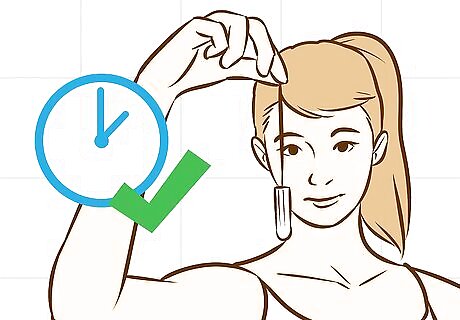
Take your time. Don’t feel the need to rush. Even if you just spend some time examining the tampon itself that can be considered progress. Also, it is better to go slowly and have a good experience than to rush and never consider using a tampon again.
Inserting and Removing a Tampon
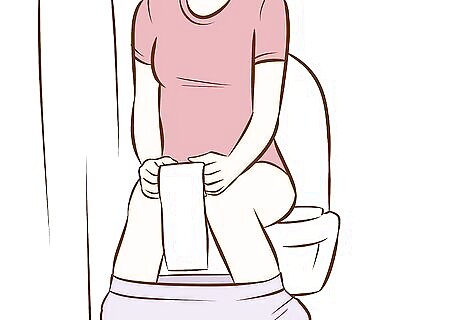
Assume a squatting or sitting position. You can sit on a toilet and try to insert it that way, but many people find it easier to assume an alternate position. You can place one leg up on the toilet seat for wider access to your vaginal area. Or, you can try a squatting position, spreading your legs more apart. Feel free to explore various options to see what works the best for you. For the first time, some people prefer to avoid the bathroom entirely. Instead, you can lay back on your bed and open your legs. Or, stand a use a chair for balance.
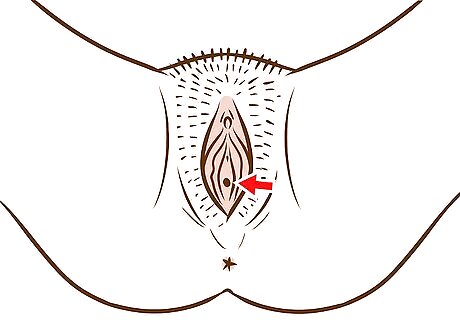
Locate your vaginal opening. Use your finger to locate the entry to your vagina, as you saw in the mirror before. Then, guide the tip of the applicator to the opening. If you are inexperienced in tampon use, you will find that this is less scary and easier to do than moving around the applicator in search of an entry point.

Grasp the grip area of the tampon. Position your middle finger and thumb on both sides of the grip, holding firmly. Your middle finger can then go to the end of the plunger. Of course, you can experiment with this hand hold until you find a position that works the best for you. The key is to keep a good grasp of the tampon in the grip area.
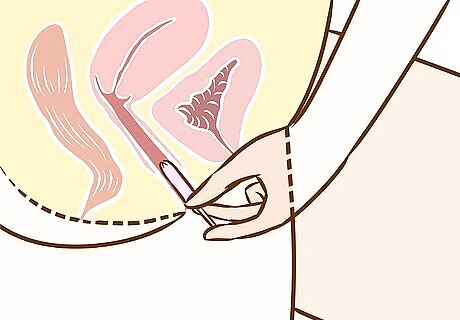
Insert the tip of the applicator. Gently guide the applicator tip into your vaginal canal. The entire applicator should fit inside you with the grip portion and your fingers staying outside of you. So, the barrel portion is inside and the grip is outside. The applicator should be in a position that is parallel to the floor. If you try to push the applicator vertical, you will hit the upper wall of your canal. If the area is sufficiently lubricated, the tampon applicator should slide smoothly in. You should not have to push it hard or jab it at all. This is the step that presents the most problems for first-time users. If you need to, take a few deep breaths and pause before moving the applicator in.
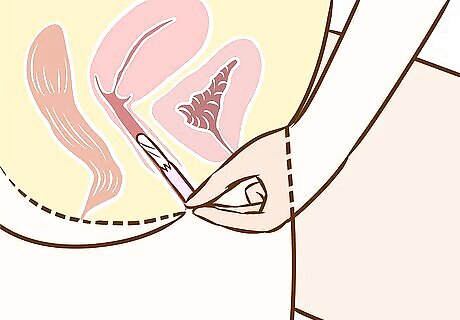
Push the plunger inside. Flex your middle finger on the end of the plunger and push down until it is flush with the applicator. Keep your hold on the grip the entire time. When the plunger is fully down, then tighten your fingers on the grip and pull the applicator out of your vagina. If your applicator was pushed enough inside of you, you should not feel the tampon at all. If you released the tampon too low, you will likely feel its presence and slight discomfort. If this is the case, simply pull on the string to remove that tampon and try the process over again with a fresh one.
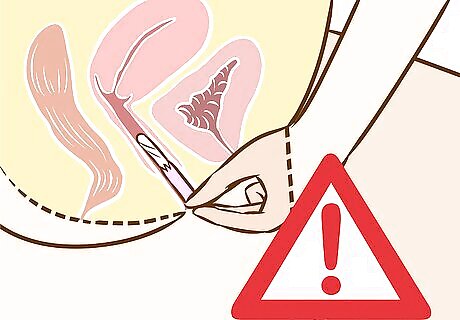
Stop if you feel any pain. It is common to feel discomfort as you insert a tampon the first time. This is likely caused by nerves or perhaps a too-low positioned tampon. However, you should not experience any type of pain. If this happens, stop what you are doing immediately. You may want to try again or just go ahead and talk with a doctor.
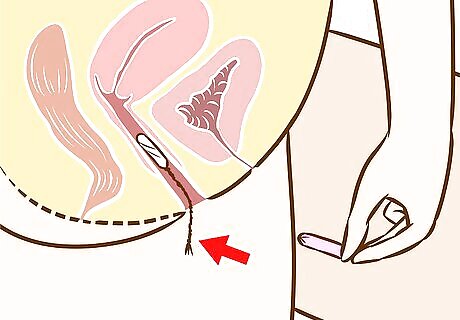
Remove by gently pulling downward on the string. When your tampon is fully inserted, you will see the string still hanging out of you. This is exactly what you should see. Don’t push the string up into you, leave it out. When you are ready to remove your tampon, grab the string and pull gently downward. The tampon should slide out as you continue to hold the string. Some people prefer to remove a tampon prior to urinating, so that the urine is not soaked into the string. Also, make sure to properly dispose of all parts of the tampon once you are finished using them. It is generally not a good idea to flush any part of a tampon down the toilet.

Switch out tampons regularly. Follow the usage guidelines included in your tampon package, but is generally a good idea to switch out tampons every 4 hours. If you have a heavier flow, performing more frequent switches is a good idea too. Knowing your tampon schedule will take some of the stress off your mind. Some people also prefer to alternate between using a pad and tampon. This is an especially good idea for overnight. Making sure to regularly switch out your tampons can help to prevent Toxic Shock Syndrome (TSS). This is a potentially deadly illness that is generally preventable with careful tampon use.

Keep trying if you fail the first time. If you just can’t manage to get that tampon in the first time, it is okay. You are not alone in this situation. Many people try out tampons once only to delay until later. Or, you can always switch to pads as well. Do what works the best for you and don’t forget to reach out for help if you need it.


















Comments
0 comment